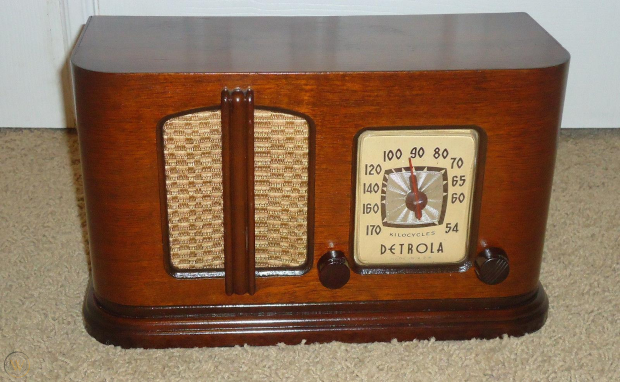The Little Detrola Radio That Brought Magic Into My Home

I remember the Detrola table model radio being on the end of the kitchen counter close to the window. Part of the morning ritual was turning it on to hear the mellow voice of Clint Buehlman giving the weather and traffic reports. If I was real lucky he would be giving the school closings, and maybe, just maybe, he would be closing mine.
The radio was magic. I didn't know how it worked. I could figure out the gas stove. Just a pipe to the burner, light a match and one could boil water. I crawled behind the refrigerator one day, only to find a mechanical hutch for dust bunnies. One couldn't get excited about a stove or fridge.
What made the radio work? I peeked in the back, being careful not to get a shock. The five tubes glowed with a reddish-orange light. I saw the dial light. I could see the dial cord move when I turned the tuning knob. Oh, it has some wires, and a metal chassis, but unlike my bike or scooter, I couldn't see what made it work.
On Sunday evenings my parents would take it into the living room, place it on a chair and we would listen to our special programs. "Good evening Mr. and Mrs. America and all the ships at sea." Wow! The same guy who was talking to us was broadcasting to the ships far out at sea! Yes, we enjoyed the Lone Ranger, Gunsmoke and all the usual favorites, while we waited for television to be improved. Maybe next year my dad would buy a TV but for now the radio would do.
Even after the TV came, the radio was still part of the morning routine. With the advent of top 40 stations of the 1950s and early '60s, the old wooden radio seemed out of place. Old programs should come out of it, not the "latest and greatest hits," but still the radio did its yeoman's duty.
Through the years, with technical study, I found out how it worked. I was able to keep it in repair by replacing tubes, the line cord and dial cord. It is a simple radio.
A few years ago, I was able to purchase a "state of the art" radio. It is completely solid state, microprocessor-controlled and has 32 memories. It took me a few hours just to learn how to operate it. It covers the broadcast band and the entire high frequency region. It can do all modes: AM, FM, Sideband and Radioteletype, as well as being controlled by a computer.
It does this with cold efficiency, and I do mean cold. It has no tubes. No heat from tubes. It has no memories of school day mornings and Sunday evening programs.
The Old Wooden Radio is mine now, and with it I can tune in to the warmth of bygone years. I still peek into the back of it, because real radios glow in the dark.
Martin Braun in Illustrated Press, November 1990
Add a Comment
All comments are moderated before publication. These HTML tags are permitted: <p>, <b>, <i>, <a>, and <blockquote>.
Top 10 Articles
- The Marriage of Don Ameche and Honore Prendergast
- The Night Arthur Godfrey Fired a Singer On Live Radio
- Early Radio Announcers Invented Their Profession in the 1920s
- The Mythical Town of East Tincup, Colorado
- The Earliest Radio Shows of the 1920s
- The Great Radio Detectives of the 1950s
- The Home Life of Jack Benny
- Why Vladimir Horowitz Stopped Performing in the 1930s
- Judy Canova: The Queen of Hillbilly Hokum
- Some of the Unsung Heroes of Radio

